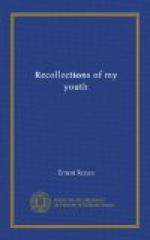Theology may be divided into dogmatics and ethics. Dogmatic theology, in addition to the Prolegomena comprising the discussions relating to the sources of divine authority, is divided into fifteen treatises upon all the dogmas of Christianity. At the basis is the treatise De la vraie Religion, which seeks to demonstrate the supernatural character of the Christian religion, that is to say of Revealed Writ and of the Church. Then all the dogmas are proved by Holy Writ, by the Councils, by the Fathers, and by the theologians. It cannot be denied that there is a very frank rationalism at the root of all this. If scholasticism is the descendant in the first generation of St. Thomas Aquinas, it is descended in the second from Abelard. In such a system reason holds the first place, reason proves the revelation, the divinity of Scripture and the authority of the Church. This done, the door is open to every kind of deduction. The only instance in which St. Sulpice has been moved to anger since the extinction of Jansenism was when M. de Lamennais declared that the starting-point should be faith, and not reason. And what is to be the test in the last resort of the claims of faith if not reason!
Moral theology consists of a dozen treatises comprising the whole body of philosophical ethics and of law, completed by the revelation and decisions of the Church. All this forms a sort of encyclopaedia very closely connected. It is an edifice, the stones of which are attached to one another by iron clamps, but the base is extremely weak. This base is the treatise De la vraie Religion, which treatise does not hold together. For not only does it fail to show that the Christian religion is more especially divine and revealed than the others, but it does not even prove that in the field of reality which comes within the reach of our observation there has occurred a single supernatural fact or miracle. M. Littre’s inexorable phrase, “Despite all the researches which have been made, no miracle has ever taken place where it could be observed and put upon record” is a stumbling-block which cannot be moved out of the path. It is impossible to prove that a miracle occurred in the past, and we shall doubtless have a long time to wait before one takes place under such conditions as could alone give a right-minded person the assurance that he was not mistaken.




